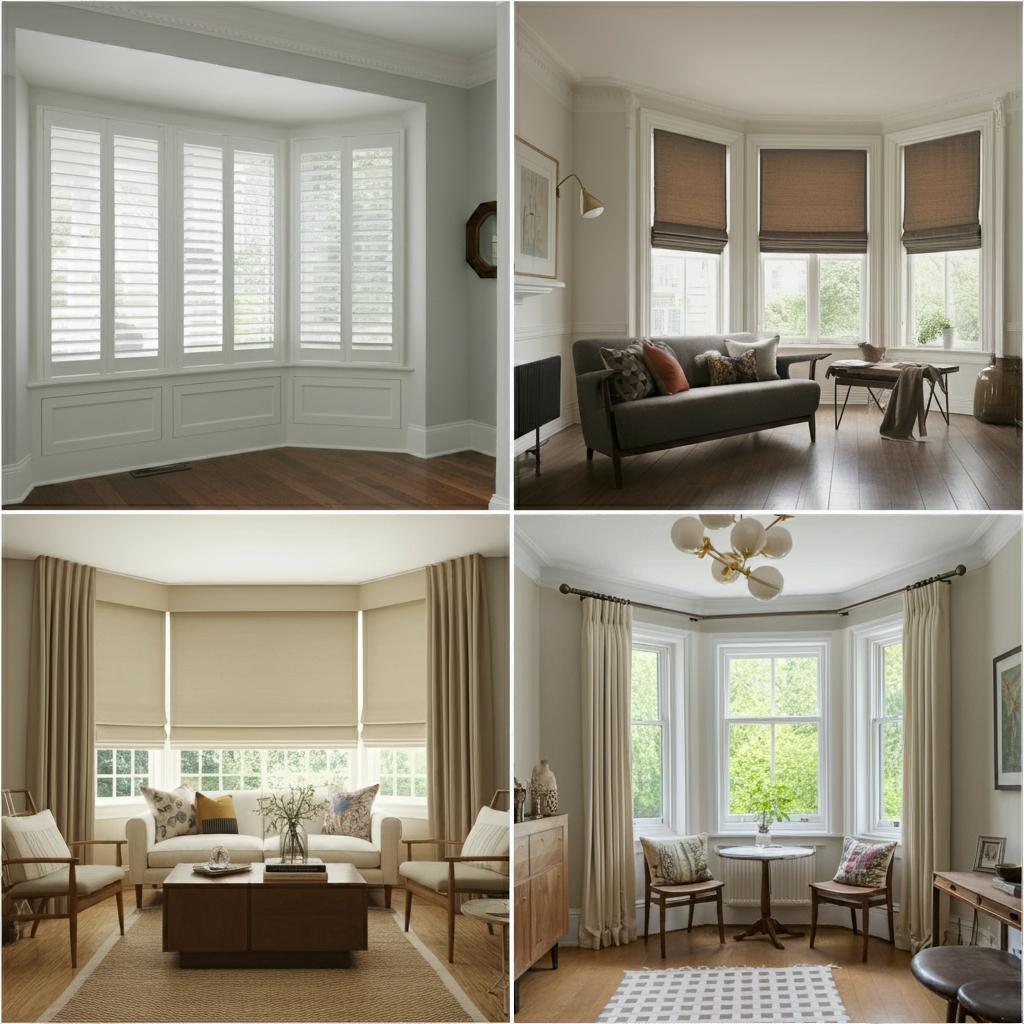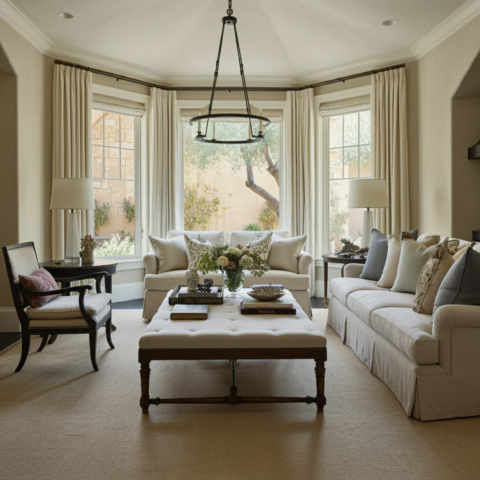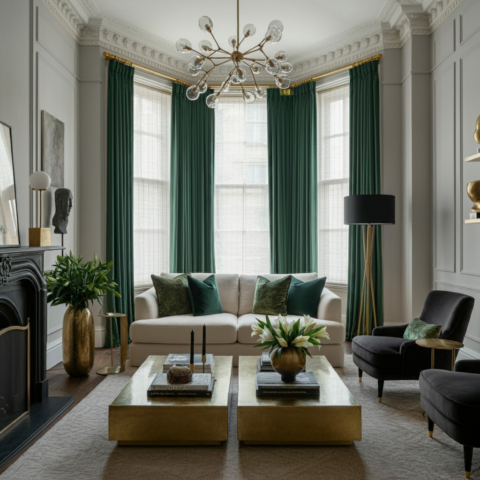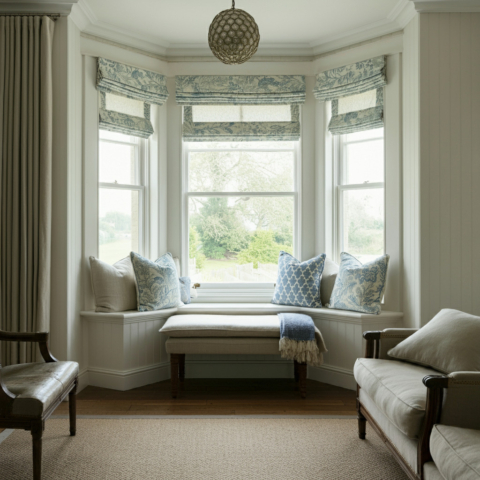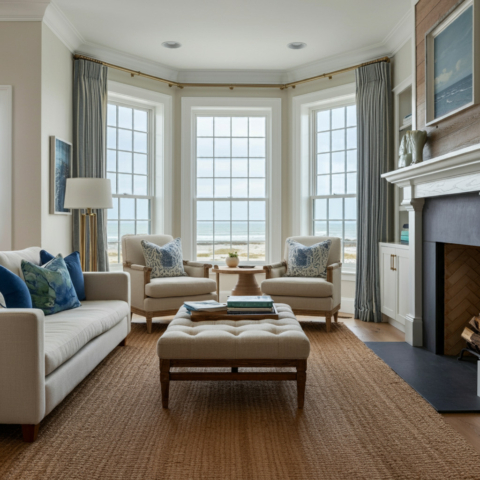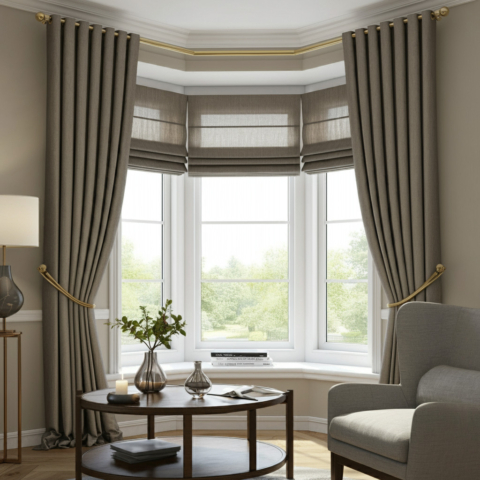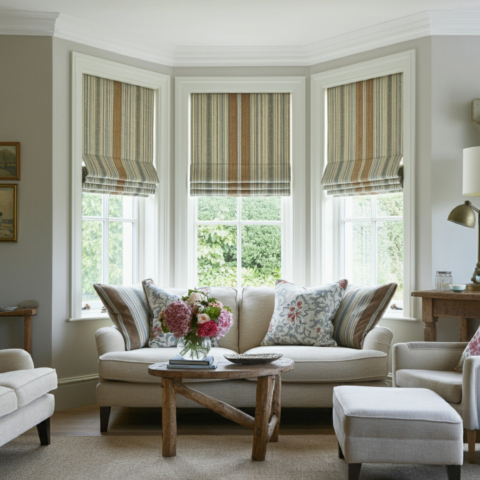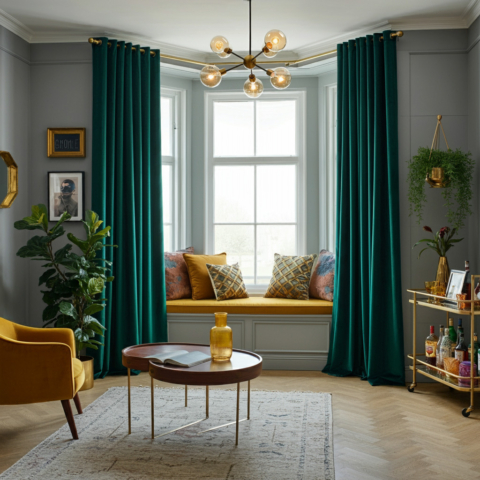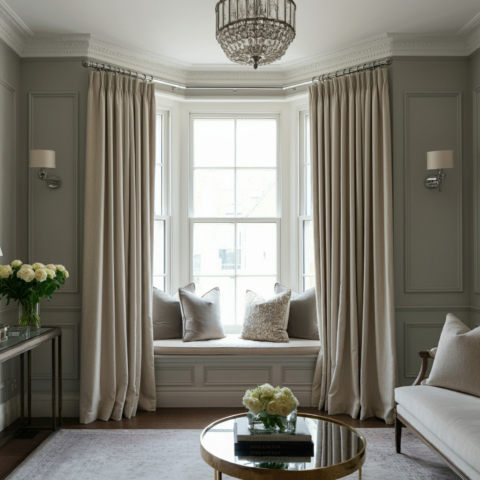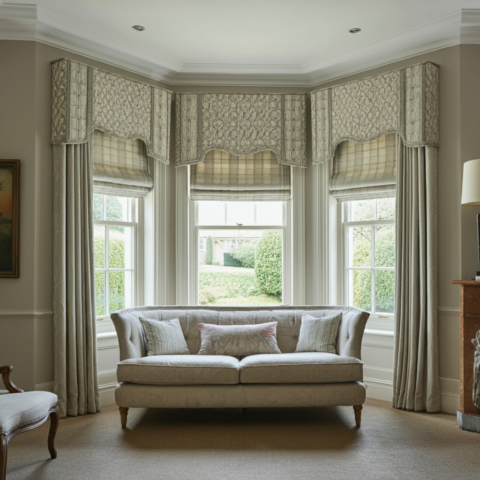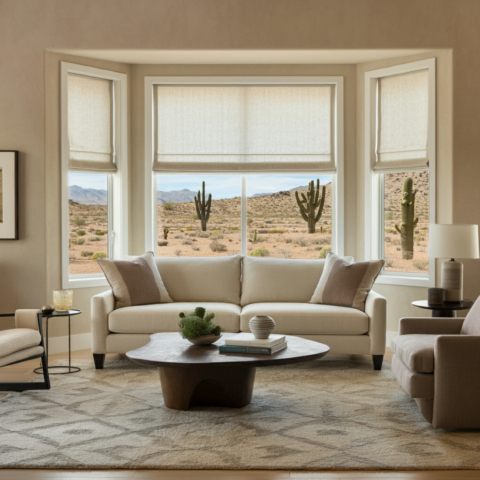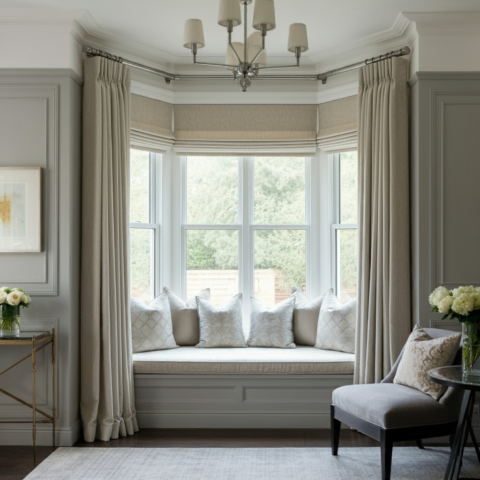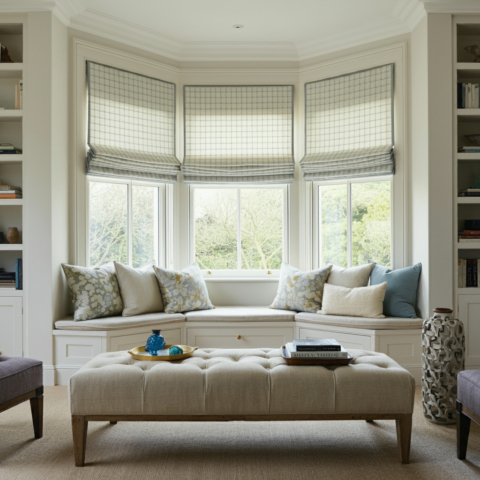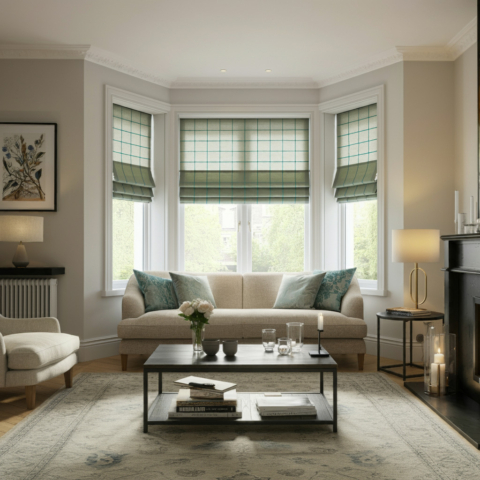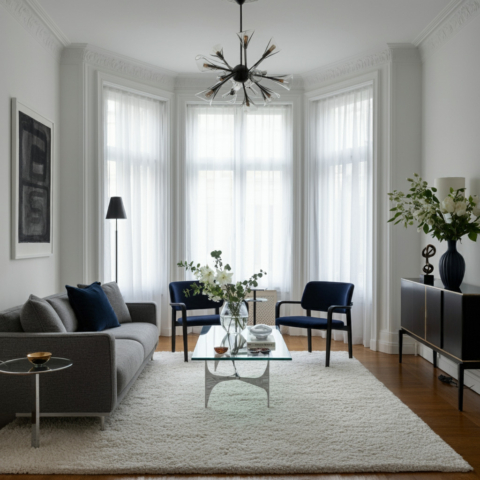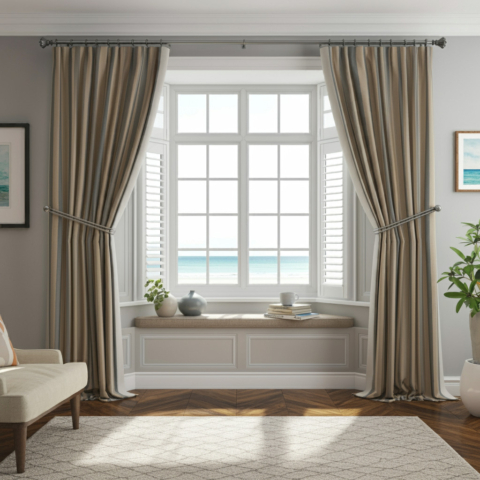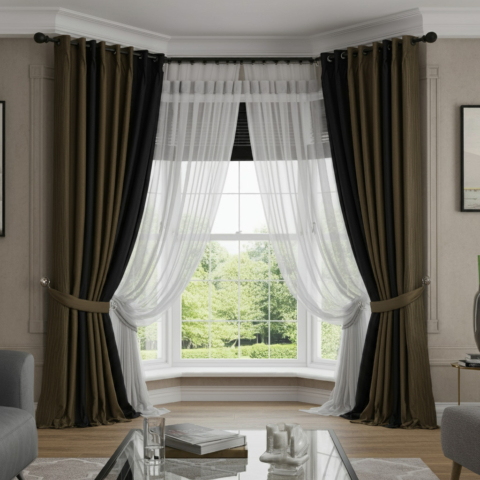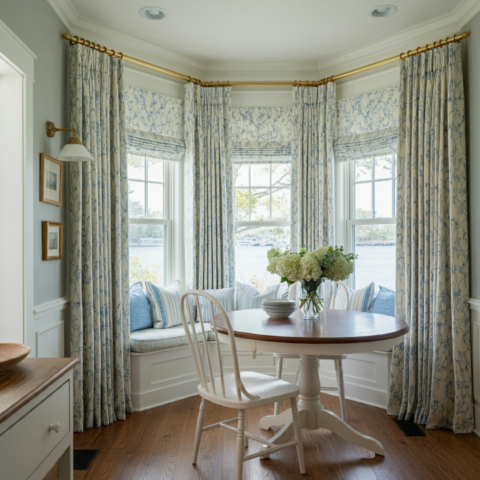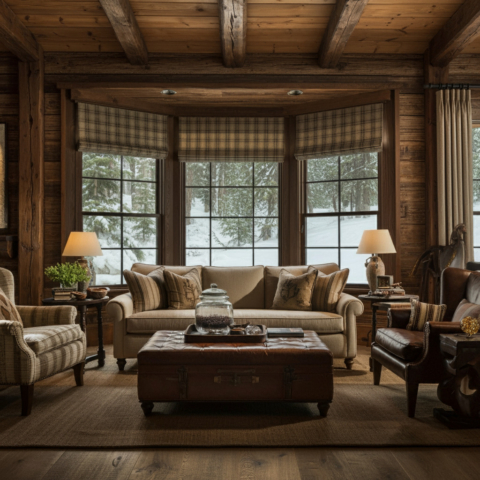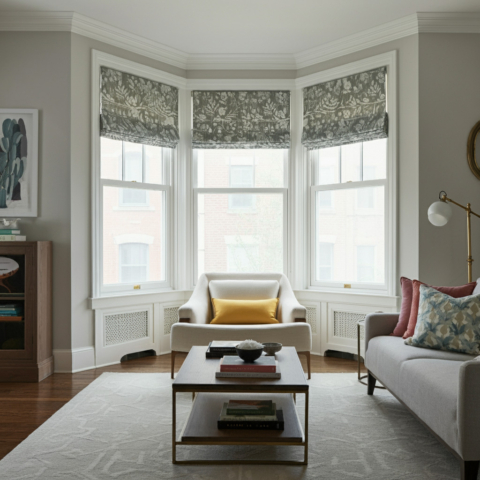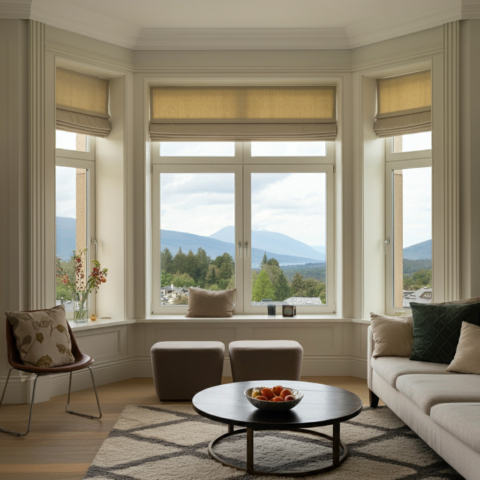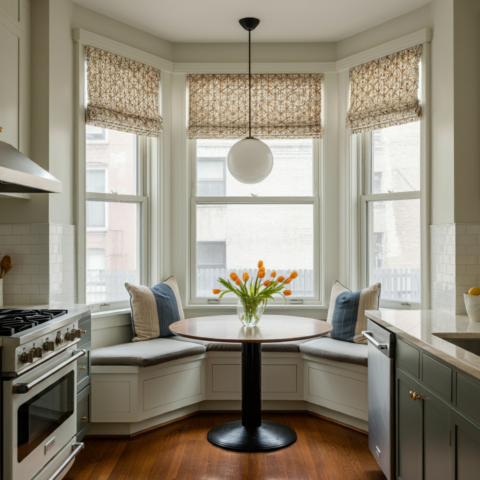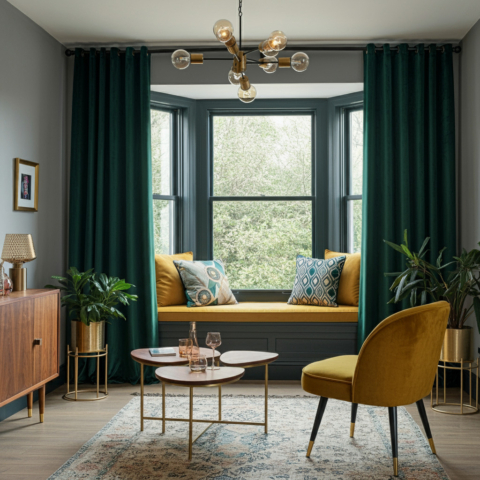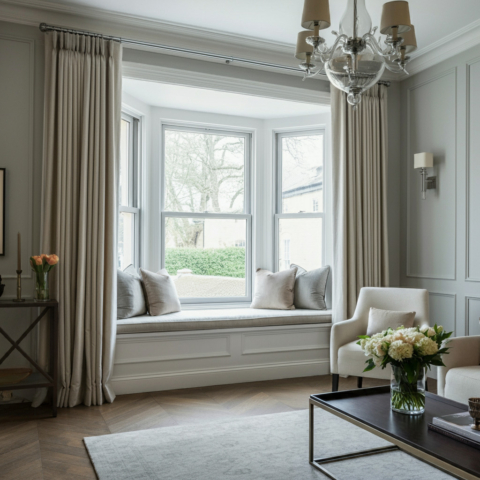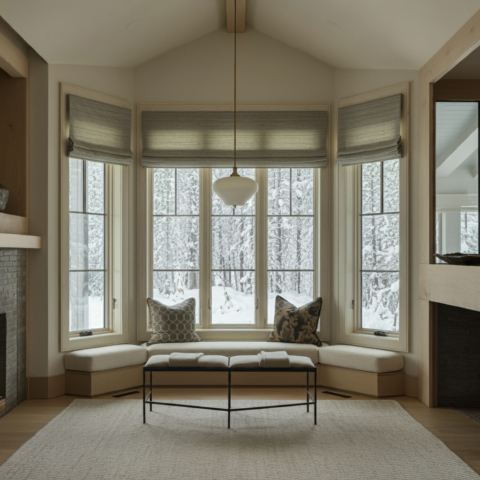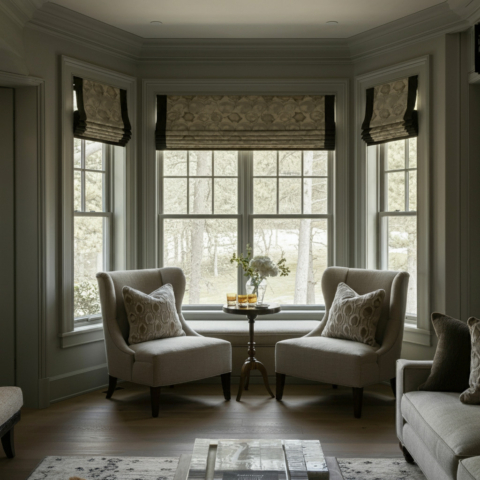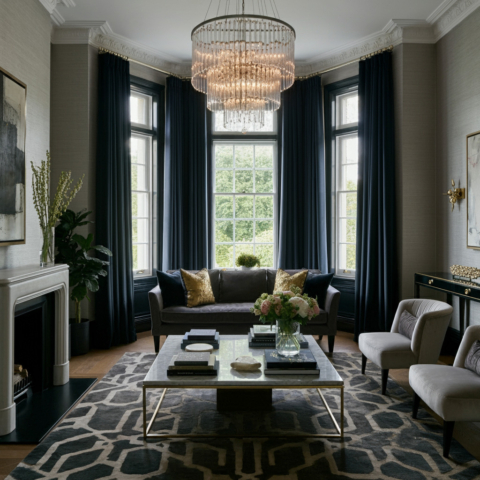Table of Contents
- Introduction
- Types of Bay Window Treatments
- Shutters
- Blinds
- Curtains and Drapes
- Roman Shades
- Choosing the Right Window Treatment
- Room Function and Style
- Light Control and Privacy Needs
- Budget Considerations
- Combining Different Types of Treatments
- Measuring and Installing Bay Window Treatments
- Measuring for Accuracy
- Installing Curtain Rods
- Specific Rod Configurations
- Where to Find Bay Window Curtain Rods
- Recommended Retailers
- Custom Drapery Rods
- Conclusion
- Appendix: Advanced Tips for Bay Window Treatments
- Maximizing Light Control and Privacy
- Enhancing Aesthetic Appeal
- Dealing with Unusual Bay Window Configurations
- Advanced Measuring and Installation Tips
- Bay Window Photo Gallery
- FAQ: Bay Window Treatments
- Can I combine different types of window treatments on a bay window?
- How do I handle unusual bay window angles when installing curtain rods?
- What are the benefits of using motorized blinds or shades for bay windows?
- How do I choose the right length for curtains on bay windows?
- Are there eco-friendly options for bay window treatments?
- What are some tips for maintaining bay window treatments?
- How can I ensure privacy with bay window treatments without sacrificing natural light?
- What are some decorative options for bay window treatments?
- How do I choose the right hardware for bay window treatments?
- Can I use bay window treatments to enhance room acoustics?
I. Introduction
In this definitive guide, we will explore the various options for window coverings specifically designed for bay windows, including drapery and curtain rods for bay windows, shutters, blinds, and Roman shades. We will delve into the intricacies of choosing the right treatments, the combination of different types for optimal results, and the essential aspects of measuring and installing these window coverings. Additionally, we will provide insights on where to find the best window covering for bay windows.
Bay windows are architectural features that add charm and character to any home. They create a sense of spaciousness, provide an abundance of natural light, and offer picturesque views of the outdoors. However, finding the right window coverings for bay windows can be a challenging task due to their unique shape and structure. Proper window treatments can enhance the beauty of bay windows, improve functionality, and provide the desired level of privacy and light control.
Whether you are a homeowner looking to elevate the style of your bay windows or a professional seeking to enhance your knowledge, this guide will equip you with the information and best practices needed to make informed decisions and achieve stunning results. Let’s embark on this journey to discover the perfect window coverings for bay windows and transform your space into a haven of beauty and functionality.
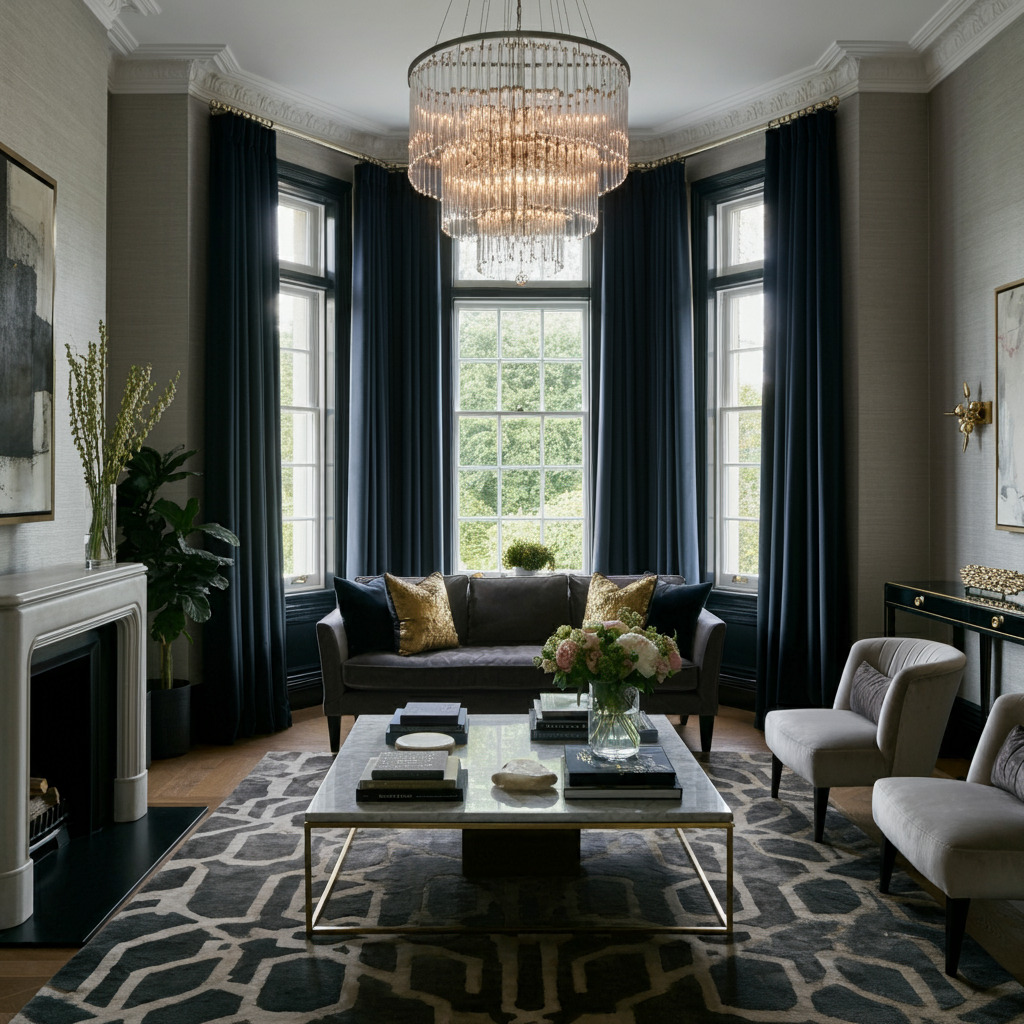
II. Types of Bay Window Treatments
Bay windows, with their unique shape and structure, offer a charming architectural feature but also present a challenge when it comes to window treatments. Finding the right solution involves balancing aesthetics with functionality. Here, we explore the various types of window coverings that are ideal for bay windows.
A. Shutters
Description and Benefits Shutters are a classic choice for bay windows, offering both elegance and practicality. They provide excellent light control and privacy while adding a touch of sophistication to any room. Shutters are also durable and easy to maintain.
Types of Shutters
- Plantation Shutters: Known for their wide louvers, plantation shutters offer a contemporary look and excellent light control.
- Café Shutters: Covering only the lower part of the window, café shutters provide privacy while allowing natural light to enter from the top.
Materials and Finishes Shutters come in various materials, including wood, vinyl, and composite. Each material offers different benefits in terms of durability, maintenance, and aesthetics. The choice of finish can range from natural wood stains to painted options, allowing for customization to match your decor.
B. Blinds
Blinds are a versatile and practical option for bay windows, offering a variety of styles to suit different tastes and needs.
Overview of Different Kinds of Blinds
- Venetian Blinds: Featuring horizontal slats, Venetian blinds provide excellent light control and are available in materials like wood, aluminum, and faux wood.
- Vertical Blinds: Ideal for large bay windows, vertical blinds have vertical slats that can be tilted for light control or drawn to one side for a clear view.
- Roller Blinds: Simple and sleek, roller blinds roll up neatly when not in use. They are available in a wide range of fabrics and designs.
- Roman Blinds: Soft and elegant, Roman blinds fold into pleats when raised. They offer a luxurious look and can be made from various fabrics.
- Cellular Blinds: Also known as honeycomb blinds, cellular blinds provide excellent insulation and energy efficiency. They come in a range of colors and opacity levels.
Benefits and Drawbacks of Each Type Each type of blind offers unique benefits, such as ease of use, light control, and insulation. However, there are also drawbacks to consider, such as maintenance requirements and suitability for different window shapes.
C. Curtains and Drapes
Curtains and drapes add a touch of elegance and warmth to bay windows. They offer a wide range of customization options in terms of fabric, style, and hardware.
Choosing the Right Fabric and Style Select fabrics based on the room’s decor and functional needs. Light, airy fabrics work well for a casual look, while heavier fabrics provide a more formal appearance and better insulation.
Drapery Rod Styles for Bay Windows
- French Returns: These rods curve back towards the wall, providing a seamless look and preventing light from leaking through the sides.
- Finial Rods: Featuring decorative end pieces, finial rods add a touch of style and elegance to your drapery setup.
Focus on Metal Rods Metal rods are durable and stylish, available in various finishes like brass, nickel, and black. They offer a contemporary look and can support heavier drapes.
Drapery Hardware
- Support Brackets: Essential for holding the rod in place, especially for heavy drapes.
- Center Brackets: Used for additional support in the middle of long rods to prevent sagging.
- Wands: Useful for opening and closing drapes without touching the fabric.
- Drapery Rings: Allow the drapes to slide smoothly along the rod.
- C‑Rings: Designed for use with traverse rods, allowing the drapes to open and close easily.
- Passover Brackets: Enable drapery rods to pass over corners seamlessly.
- Corner Connectors: Specifically designed for bay windows to connect rods at angles.
D. Roman Shades
Roman shades combine the softness of fabric with the functionality of blinds. They offer a stylish and versatile option for bay window treatments.
Description and Benefits Roman shades fold neatly into pleats when raised, providing a clean and tailored look. They are available in various styles, including flat, hobbled, relaxed, and butterfly, each offering a different aesthetic.
Styles of Roman Shades
- Flat Roman Shades: Provide a sleek and modern look with minimal pleats.
- Hobbled Roman Shades: Feature soft, cascading folds for a more traditional and elegant appearance.
- Relaxed Roman Shades: Have a gentle curve at the bottom, creating a casual and relaxed feel.
- Butterfly Roman Shades: Feature a decorative, fan-shaped design for a unique look.
Customization Options Roman shades can be customized with different fabrics, linings, and trims. Choose light-filtering or blackout linings depending on your privacy and light control needs.
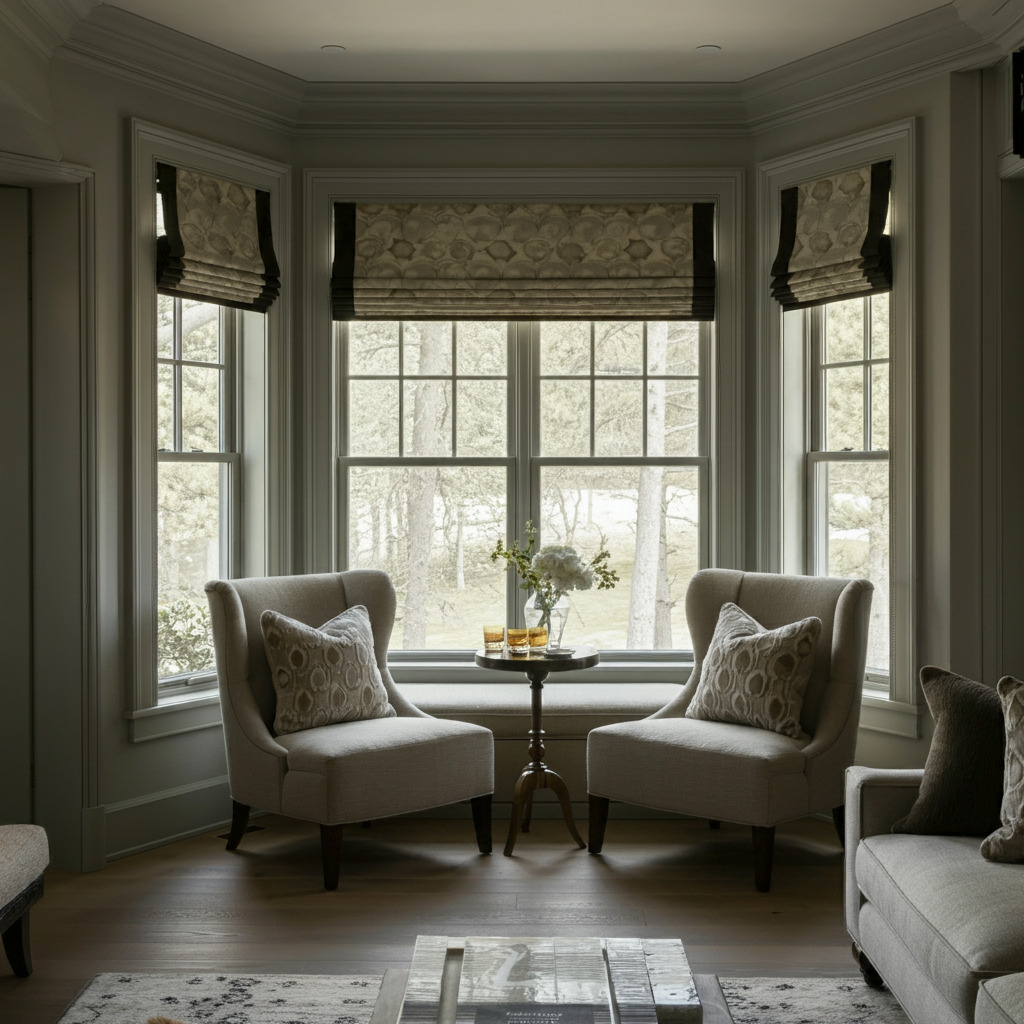
III. Choosing the Right Window Treatment
Selecting the perfect window treatment for bay windows involves balancing aesthetics, functionality, and the specific needs of your space. The following guidelines will help you make an informed decision.
A. Factors to Consider
1. Room Function and Style
- Purpose of the Room: Consider the primary use of the room. A living room may benefit from elegant drapes or Roman shades, while a bedroom might require blackout curtains or cellular blinds for privacy and light control.
- Decor Style: Match your window treatments to the room’s existing decor. Choose fabrics and finishes that complement your interior design, whether it’s modern, traditional, or somewhere in between.
2. Light Control and Privacy Needs
- Natural Light: Determine how much natural light you want to allow into the room. Light-filtering shades or sheer curtains can brighten a space, while blackout curtains are ideal for blocking light in bedrooms or media rooms.
- Privacy: Depending on the location of the window and your privacy needs, you might opt for treatments that provide full coverage, such as shutters or layered treatments like curtains over blinds.
3. Budget Considerations
- Cost of Materials: High-quality materials may be more expensive but offer greater durability and a better aesthetic. Decide on your budget and explore options within that range.
- Installation Costs: Factor in the cost of professional installation if you’re not planning to install the treatments yourself. Custom window treatments may also require specialized fittings.
B. Combining Different Types of Treatments
Layering window treatments can offer a versatile and stylish solution, providing both functionality and a unique look. Here are some ideas for effective combinations:
1. Sheer Curtains with Blackout Drapes
- Functionality: This combination offers the best of both worlds. Sheer curtains allow natural light while maintaining privacy during the day, and blackout drapes provide complete darkness and privacy at night.
- Aesthetic Appeal: Layering adds depth and sophistication to your windows, allowing you to play with different textures and colors.
2. Blinds with Valances or Cornices
- Enhanced Decor: Adding a valance or cornice above blinds can create a finished, polished look. This is an excellent option for living rooms and dining rooms where you want to add a decorative element.
- Practical Benefits: Valances and cornices can also hide hardware and the tops of blinds, providing a cleaner appearance.
3. Roman Shades with Side Panels
- Stylish Layering: Roman shades offer a tailored look when lowered, while side panels add a soft and decorative touch. This combination works well in formal settings like dining rooms or bedrooms.
- Functional Flexibility: Roman shades provide privacy and light control, and side panels can be used purely for aesthetic purposes or to frame the window.
Choosing the right window treatment for bay windows involves understanding the needs of the room, balancing light and privacy, adhering to your budget, and sometimes layering different treatments for the best results. With careful consideration and planning, you can enhance both the beauty and functionality of your bay windows, making them a standout feature in your home.
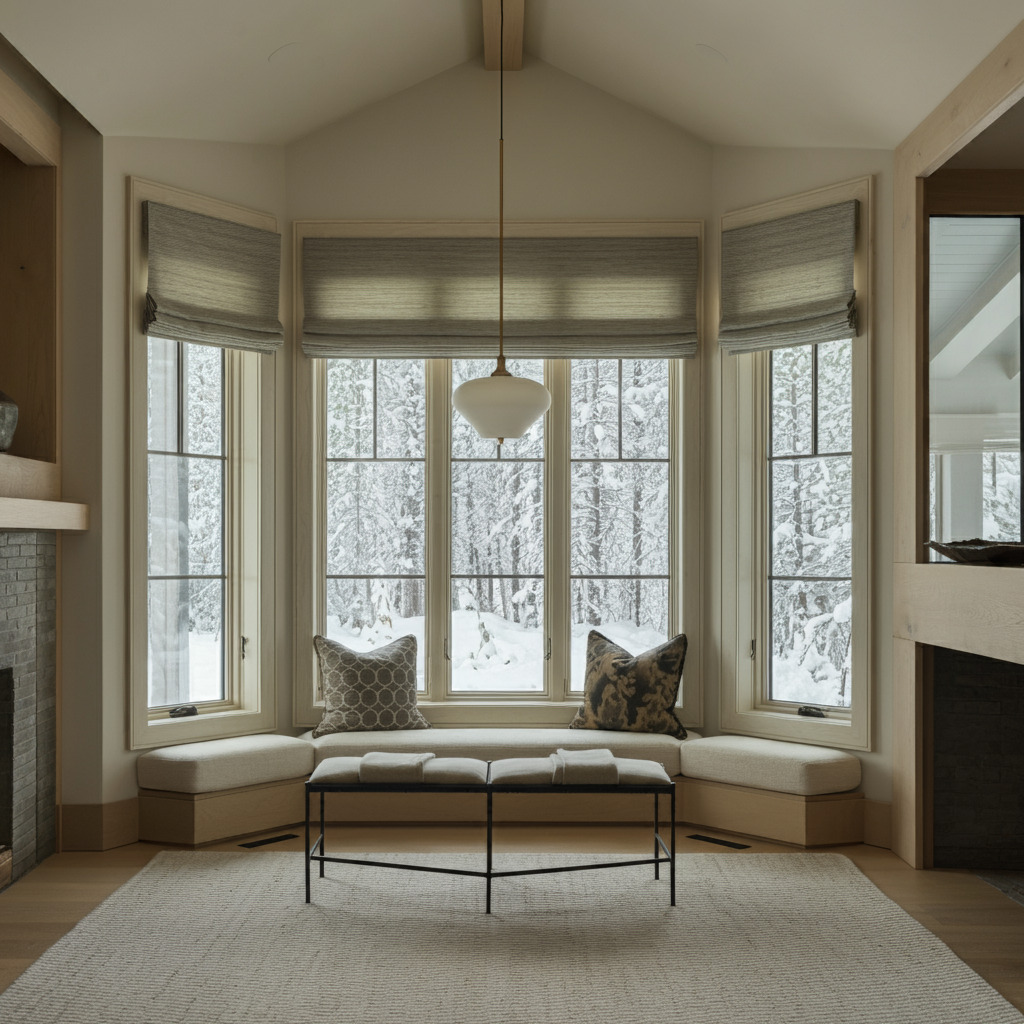
IV. Measuring and Installing Bay Window Treatments
Accurate measuring and proper installation are crucial steps in ensuring that your bay window treatments not only look great but also function effectively. Here’s a comprehensive guide to help you get it right.
A. Measuring for Accuracy
Tools Needed
- Tape measure
- Pencil
- Notepad or digital device for recording measurements
- Ladder (if necessary)
Step-by-Step Instructions for Measuring
- Measure the Width
- Inside Mount: Measure the inside width of each window section at the top, middle, and bottom. Use the narrowest measurement for precise fitting.
- Outside Mount: Measure the width of each window section from the outside edges where the treatment will be mounted.
- Measure the Height
- Inside Mount: Measure the height from the top inside edge to the window sill for each section.
- Outside Mount: Measure the height from the top of the frame or where the treatment will be mounted to the desired length.
- Measure Angles and Curves
- For bay windows with angles, measure the distance between the corners and note the angles. For curved bay windows, measure the curve’s radius if possible.
- Note Any Obstacles
- Record the location of any window handles, locks, or other obstructions that might affect the installation.
Considerations for Different Types of Treatments
- Shutters: Ensure there’s enough clearance for shutters to open fully.
- Blinds: Measure additional clearance if blinds will be mounted inside the frame.
- Curtains and Drapes: Account for stack-back space on either side of the window to allow drapes to be drawn fully open.
- Roman Shades: Measure for a snug fit to avoid gaps at the sides.
B. Installing Curtain Rods
How to Hang Curtain Rods for Bay Windows
- Determine Rod Placement
- Decide if the rods will be mounted inside or outside the window frame. Outside mounts typically offer more flexibility and visual impact.
- Mark the Bracket Locations
- Use a pencil to mark where each bracket will be placed. Ensure the brackets are level and aligned correctly with the window’s angles.
- Install the Brackets
- Drill pilot holes at the marked locations and securely attach the brackets using appropriate screws and wall anchors.
- Attach the Rods
- Assemble the rod sections and attach them to the brackets. For bay windows, use corner connectors to join the rods at angles.
Common Challenges and Solutions
- Aligning Brackets: Use a level to ensure all brackets are perfectly aligned.
- Securing Hardware: Use wall anchors if mounting on drywall to ensure the brackets can support the weight of the treatments.
- Adjusting for Angles: Use corner connectors specifically designed for bay windows to ensure a seamless fit.
C. Specific Rod Configurations
3‑Sided Bay Window Curtain Rod
- Ideal for smaller bay windows with three sections.
- Use corner connectors to join the rods at the correct angles.
4‑Sided Bay Window Curtain Rod
- Suitable for larger bay windows with four sections.
- Ensure proper support in the center of longer rod sections to prevent sagging.
5‑Sided Bay Window Curtain Rod
- Used for expansive bay windows with five sections.
- Requires precise measurement and additional corner connectors for stability.
Measuring and installing window treatments for bay windows requires careful attention to detail and a thorough understanding of the specific requirements of each type of treatment. By following these guidelines, you can achieve a perfect fit and professional finish that enhances the beauty and functionality of your bay windows. With the right tools, measurements, and installation techniques, your bay window treatments will not only look stunning but also provide the privacy, light control, and aesthetic appeal you desire.
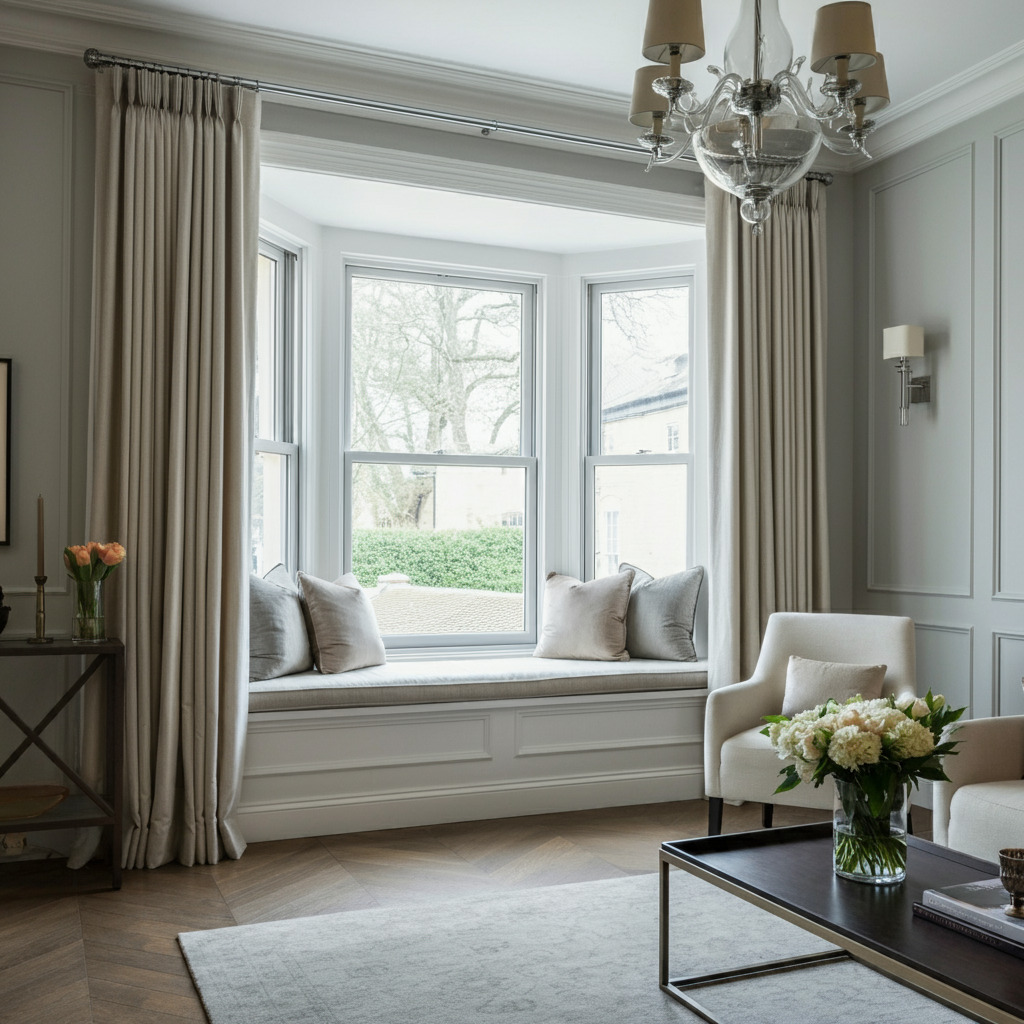
V. Where to Find Bay Window Treatments
Finding the perfect curtain rods for bay windows can be a daunting task given their unique angles and shapes. Here, we explore some reliable sources and tips to make the search easier.
Recommended Retailers
1. Bay Window Curtain Rods – IronRods
- Overview: Known for their high-quality custom drapery rods, specializes in providing solutions for challenging window configurations, such as bay and corner windows. They offer a range of styles and finishes to match any décor. You can see their entire drapery rod collection online at ironrods.com
- Products: Customizable iron rods, corner connectors, and various drapery hardware.
- Benefits: High durability, bespoke designs, and a wide selection of rod and hardware options.
- Contact Info: ironrods.com | (615) 350‑6655
2. Custom Drapes & Roman Shades – The Fabric House
- Overview: Located in Nashville Tennessee, Fabric House is renowned for its exceptional custom drapery services, offering tailor-made solutions that cater to the specific needs of each client. Specializing in intricate window configurations, including bay windows, The Fabric House provides an extensive selection of styles and finishes to complement any decor.
- Products: Their offerings include a diverse array of high-quality fabrics in various patterns, textures, and colors, allowing clients to customize their drapes to match their personal style and home decor. They also provide a wide range of drapery styles, from traditional to contemporary, ensuring that every window treatment is unique and tailored to the client’s aesthetic preferences.
- Benefits: Clients benefit from high durability and bespoke designs that reflect individual style and preference. The Fabric House’s diverse selection of fabrics and drapery styles ensures that each piece is not only functional but also adds to the overall aesthetic appeal of the space.
- Contact Info: fabrichousenashville.com | (615) 837‑0000
3. Blinds & Shutters – Advanced Window Coverings
- Overview: Located in Franklin Tennessee, Advanced Window Covering specializes in high-quality blinds and shutters, offering innovative and aesthetically pleasing solutions. They are experts in handling challenging window configurations, including bay windows
- Products: They provide various types of blinds such as Venetian, vertical, roller, Roman, and cellular blinds, as well as custom-made plantation and café shutters.
- Benefits: Customers enjoy durable, versatile, and custom-fit window treatments that enhance privacy, light control, and energy efficiency, all crafted from high-quality materials for long-lasting performance.
- Contact Info: advancedwindowcoverings.net | (615) 708‑8154
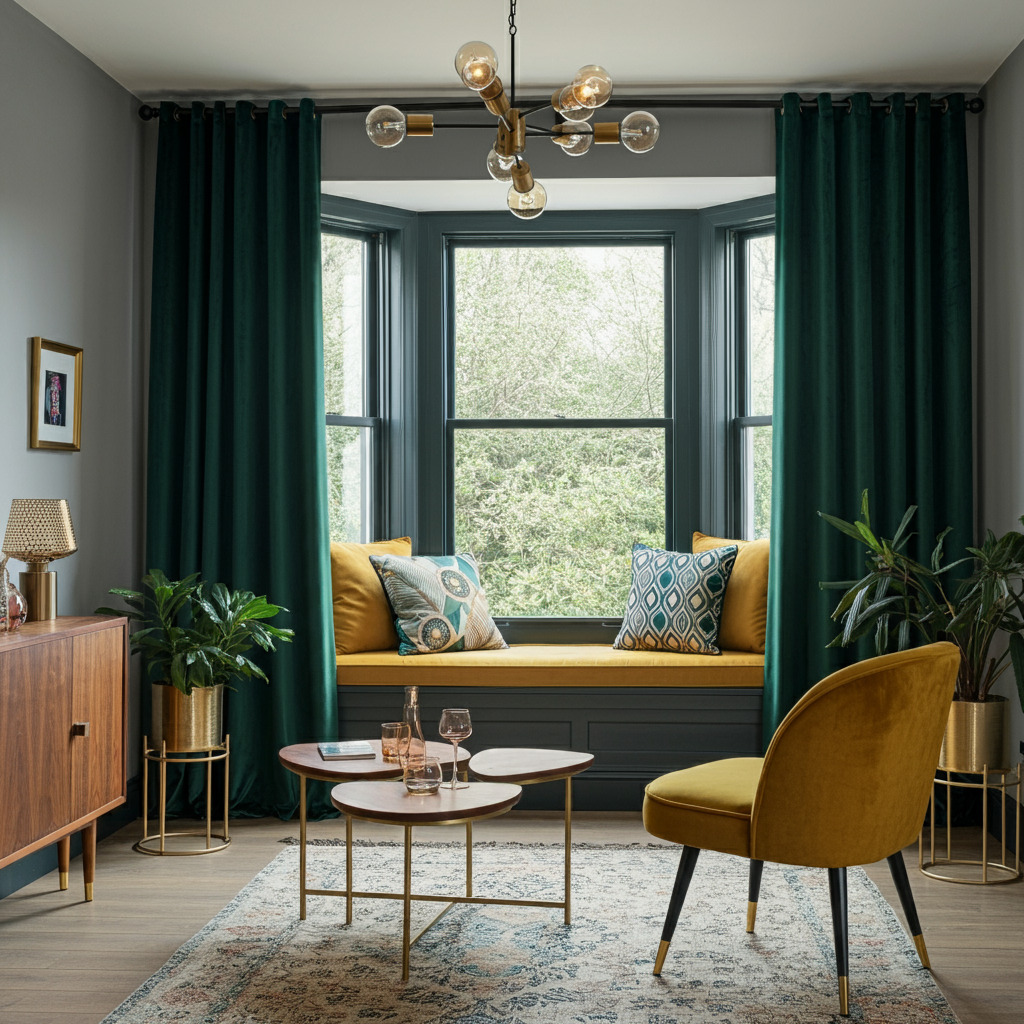
VI. Conclusion
Selecting the right window treatments for bay windows can transform these architectural features into stunning focal points that enhance the overall aesthetic and functionality of your space. From classic shutters and versatile blinds to elegant curtains, drapes, and Roman shades, there is an array of options available to suit different tastes, needs, and budgets.
By considering factors such as room function, light control, privacy needs, and budget, you can make informed decisions that align with your design goals. Combining different types of treatments can offer both practicality and style, creating a layered look that adds depth and sophistication to your interiors.
Accurate measuring and proper installation are crucial to achieving a perfect fit and professional finish. With the right tools and techniques, you can ensure your window treatments look and perform their best.
The journey to perfecting your bay window treatments involves a blend of creativity, precision, and careful planning. By following the guidelines and tips provided in this guide, you can enhance the beauty and functionality of your bay windows, creating inviting and stylish spaces that reflect your personal taste and lifestyle. Explore, experiment, and enjoy the process of transforming your bay windows into stunning features that elevate your home.
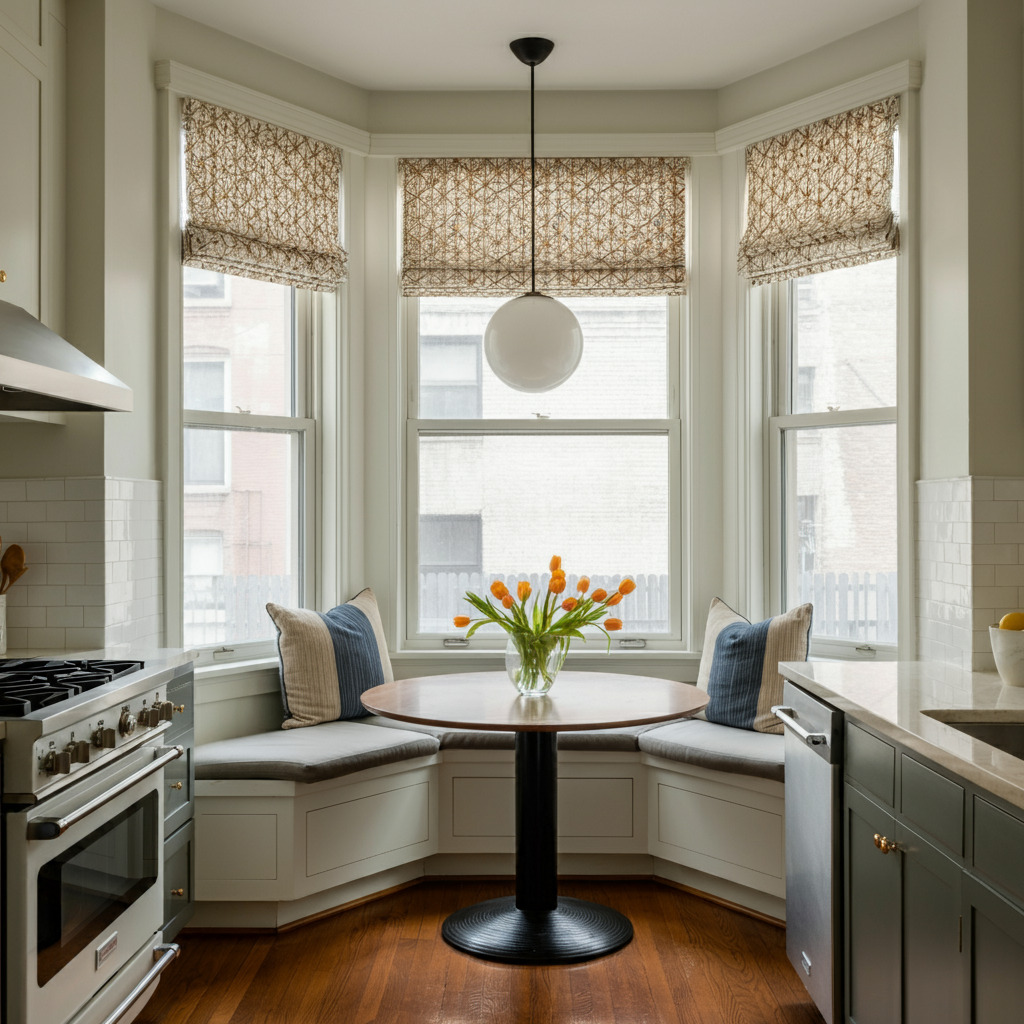
Appendix: Advanced Tips for Bay Window Treatments
This appendix provides additional insights and advanced tips to help you achieve the best results with your bay window treatments. By considering light control, aesthetic appeal, custom solutions, and precise measuring and installation techniques, you can enhance the beauty and functionality of your bay windows to fit your unique needs.
A. Maximizing Light Control and Privacy
1. Layering Treatments
- Purpose: Combining different types of treatments, such as blinds and curtains, can provide flexible light control and enhanced privacy. Layering also adds depth and visual interest to the window.
- Examples: Pair sheer curtains with blackout drapes or layer Roman shades with side panels for a balanced mix of functionality and style.
2. Using Linings
- Types of Linings: Consider adding linings to your drapes and curtains. Blackout linings can provide complete privacy and block out light, while thermal linings help with energy efficiency by insulating the room.
- Benefits: Linings not only improve the functionality of your window treatments but also add weight and structure, enhancing the overall appearance.
B. Enhancing Aesthetic Appeal
1. Choosing the Right Fabrics and Colors
- Fabric Selection: Select fabrics that complement the room’s decor. Lighter fabrics work well in casual settings, while heavier fabrics offer a more formal look. Patterns and textures can add visual interest and personality.
- Color Coordination: Choose colors that either blend with the room’s palette for a cohesive look or opt for contrasting colors to make a bold statement.
2. Decorative Hardware
- Finials and Rods: Decorative finials and rods can serve as focal points. Choose styles that match the overall design theme of the room. Metal rods in finishes like brass, nickel, or matte black offer a contemporary look.
- Additional Hardware: Explore different drapery hardware such as tiebacks, holdbacks, and decorative rings to add an extra touch of elegance and functionality.
C. Dealing with Unusual Bay Window Configurations
1. Custom Solutions
- Custom Drapery Rods: For uniquely shaped or sized bay windows, custom drapery rods ensure a perfect fit. Companies like IronRods offer customization options tailored to your specific needs.
- Custom Drapes and Shades: Consider having drapes or shades custom-made to fit the exact dimensions and angles of your bay window. This ensures a polished and professional appearance.
2. Corner Connectors and Flexible Rods
- Corner Connectors: Use corner connectors to join rods at various angles seamlessly. This is especially useful for multi-sided bay windows.
- Flexible Rods: Flexible rods can be bent to fit the contours of curved bay windows, providing a tailored look without gaps.
D. Advanced Measuring and Installation Tips
1. Measuring for Complex Bay Windows
- Tools and Techniques: Use a laser distance measurer for precise measurements, especially for multi-sided or curved bay windows. Ensure you account for any protrusions or obstacles that might affect the fit.
- Document Everything: Record all measurements carefully and double-check for accuracy. It’s helpful to sketch the window layout and note measurements on the diagram.
2. Installation Tips for Heavy Drapes and Complex Rods
- Securing Brackets: For heavy drapes or complex rod configurations, ensure brackets are securely fastened using wall anchors or toggle bolts. This provides the necessary support and prevents sagging.
- Balancing Aesthetics and Function: Make sure the installation not only supports the weight of the treatments but also aligns aesthetically with the window and room. Symmetry and alignment are key to a professional look.
Need Inspiration
Explore our galley of stunning bay window covering images below
FAQ: Bay Window Treatments
1. Can I combine different types of window treatments on a bay window?
Yes, combining different types of window treatments can offer both aesthetic appeal and functionality. For example, layering sheer curtains with Roman shades can provide flexible light control while adding depth to the decor. This approach also allows you to play with textures and colors to create a unique look.
2. How do I handle unusual bay window angles when installing curtain rods?
Using flexible corner connectors can help manage the angles of bay windows. These specialized hardware pieces allow the rods to bend or join at the right angles, ensuring a seamless fit. Custom drapery rods designed specifically for bay windows can also provide a tailored solution for difficult angles.
3. What are the benefits of using motorized blinds or shades for bay windows?
Motorized blinds or shades offer convenience and precision. They can be easily adjusted using a remote control or smartphone app, making them ideal for hard-to-reach bay windows. Additionally, they can be programmed to open and close at specific times, enhancing energy efficiency and privacy. This technology is particularly beneficial for those with mobility issues or for homes with large, high-up windows.
4. How do I choose the right length for curtains on bay windows?
The length of your curtains can dramatically affect the look and feel of the room. Floor-length curtains add elegance, while sill-length curtains offer a more casual look. Measure from the curtain rod to your desired endpoint, whether it’s the windowsill, below the sill, or all the way to the floor. If you prefer a more dramatic effect, consider puddling the curtains slightly on the floor.
5. Are there eco-friendly options for bay window treatments?
Yes, there are several eco-friendly options available. Look for blinds and shades made from sustainable materials like bamboo or recycled fabrics. Additionally, thermal or blackout curtains can help reduce energy consumption by maintaining indoor temperatures. Choosing natural fabrics, such as organic cotton or hemp, can also be a more environmentally conscious choice.
6. What are some tips for maintaining bay window treatments?
Regular maintenance includes vacuuming curtains and drapes with a soft brush attachment, dusting blinds and shutters, and spot-cleaning fabrics as needed. For deeper cleaning, follow the manufacturer’s instructions or consider professional cleaning services for delicate or heavy fabrics. Periodically check and tighten any hardware to ensure it remains secure.
7. How can I ensure privacy with bay window treatments without sacrificing natural light?
Layering is an effective way to balance privacy and natural light. Use sheer curtains during the day to allow light in while maintaining some level of privacy. At night, add blackout drapes or blinds for complete privacy. Top-down/bottom-up shades are also a great option, as they allow you to adjust the coverage while still letting in natural light from the top.
8. What are some decorative options for bay window treatments?
Consider adding decorative elements like tassels, trim, or patterned fabrics to your window treatments. Using contrasting curtain rods and finials can also enhance the overall look. Valances and pelmets can add a touch of sophistication and hide curtain hardware, giving your bay windows a polished appearance.
9. How do I choose the right hardware for bay window treatments?
Selecting the right hardware is crucial for both functionality and aesthetics. Opt for sturdy rods that can support the weight of your chosen fabrics. Consider adjustable or custom-made rods for a perfect fit. Decorative finials and brackets can enhance the overall look, so choose styles that complement your room’s decor.
10. Can I use bay window treatments to enhance room acoustics?
Yes, certain window treatments can help improve room acoustics by absorbing sound. Heavier fabrics like velvet or layered drapes can reduce echo and noise levels, making the space more comfortable for conversation and relaxation. Adding a thick lining to your curtains can further enhance their sound-absorbing properties.
References
- “Bay Window.” Wikipedia, The Free Encyclopedia. Available at: https://en.wikipedia.org/wiki/Bay_window. Accessed 8 November 2024.
- “Drapery.” Wikipedia, The Free Encyclopedia. Available at: https://en.wikipedia.org/wiki/Drapery. Accessed 8 November 2024.

